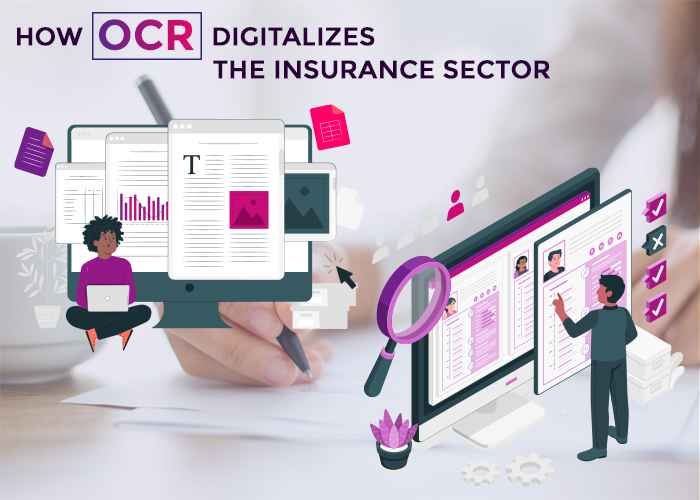
How Ocr Digitalizes The Insurance Sector?
Optical Character Recognition (OCR) technology is vital to the insurance industry's continuous digital transformation. It allows automated document onboarding, sorting, and analysis, and improves the efficiency and effectiveness of all company activities, from the insurance claim process to product development to customer support.
Continue reading to learn about four main ways insurance firms are leveraging OCR to improve financial performance and offer even better client experiences.
- OCR enhances customer service.
Prior to the introduction of OCR, insurance firms scanned paper documents and converted them into flattened digital image files. They then manually indexed each document, which required a human to re-key data received from an image on one screen into a file on another screen, and then select where that data should be placed. Manual indexing is error-prone, inconsistent, onerous, and costly due to human participation.
Manual indexing is very difficult to accomplish in many circumstances. Consider a major insurance firm that gets over 20 million papers every day. They can't recruit enough people to manually process the data, and even if they could, re-keying that volume of text would be inefficient.
Delays in the insurance business may harm the client experience. When faced with a crisis—whether it's a fire, theft, or a medical condition that demands rapid attention—people contact their insurance carrier. Delayed payments increase stress and destroy trust in a company's customer
service. Consistent delays might lead to lower client satisfaction and retention rates over time.
One insurance firm addressed the volume-versus-customer-service dilemma in an unusual way: by outsourcing a time-consuming manual procedure to its consumers. They developed a platform and app that allowed clients to scan and submit documents. After the content was submitted, it was subjected to an OCR procedure, yielding a fully text-searchable PDF document ready for automatic sorting and analysis.
This innovative method not only saved time and money but also improved customer satisfaction. Customers were in charge of their own data, and they were responsible for evaluating their contributions for the correctness and making any required modifications. Costs, mistakes, and processing time have all been cut, while service and satisfaction have grown.
- OCR assists in attracting new clients.
One of the primary ways OCR assists insurance firms in attracting more customers is by helping them to outperform their competition when it comes to matching their products and services to consumer demands. Some businesses, for example, now provide online solutions that allow prospective clients to upload a copy of their current insurance policy.
This enables automated analytics systems to examine the insurance and then compare it to the company's own products to see whether they can provide the customer with better or cheaper protection. There is no manual technique that can handle such front-end data gathering efficiently. A strong OCR method is required to automatically translate client documents into correct data in a format fit for automated analysis.
- OCR lowers expenses.
Insurance firms are constantly seeking methods to increase margins and profits while maintaining client service. OCR allows businesses to cut expenses by removing human stages in data collecting techniques and decreasing mistakes and omissions.
One office, for example, had 35 full-time staff manually analyzing and re-keying receiving paperwork. This procedure was both time-consuming and costly. They were able to decrease that manual workforce to just two individuals at the front end of their data collecting process after deploying an automated OCR procedure. And those two employees exclusively dealt with exceptions and problems, not manual indexing.
The transition from human indexing to an automated OCR procedure would have resulted in a decrease in the resources needed to onboard data on its own. Furthermore, it would have decreased the number of mistakes and omissions introduced by human data entry from 5% to as low as 2%.
However, a tiny number of mistakes account for the majority of the expenses in a data collection process, mostly in the form of time spent searching for documents that were manually indexed improperly. The tiny number of mistakes were recognized and remedied by keeping those two employees involved at the front end of the system. As a consequence, all documents were properly filed and quickly located when needed in the subsequent procedure, saving the office up to $1.25 million a year.
- OCR allows for more precise predictions.
OCR provides more benefits to insurance firms than simply enhancing data gathering. It may also be applied to the massive amounts of legacy data that businesses have amassed over time, most of it is unstructured paper and picture files. OCR can turn large data warehouses into forms that Artificial Intelligence (AI) or Machine Learning (ML) tools, such as Google's AI libraries, can use. These systems may then filter through that past data (as well as the deluge of new data) for hints pointing to market patterns, prospective changes in consumer behavior, and potential threats.
Some insurance businesses, for example, utilize OCR in conjunction with an AI solution to detect changes in client behavior related to health over time. Companies feed OCR-processed historical client data into AI solutions, which are then combined with OCR-processed data from other sources, such as census data, clinical trial findings, medical studies, or lifestyle questionnaire responses. This data may be utilized to spot trends that lead to reduced payouts or fewer claims, such as decreasing illness and mortality rates. In response to these forecasts, an insurance firm may alter the cost-versus-risk assumptions in impacted policies or develop whole new products.
Summary
In the insurance sector, optical character recognition (OCR) is the foundation of data gathering and management procedures. It helps businesses to maximize the value of their data and automated analytics technologies. OCR, for example, helps businesses to improve customer service, attract more customers, cut expenses, and even forecast the future. Without OCR, digital transformation and all of its benefits would be impossible.